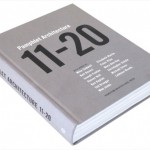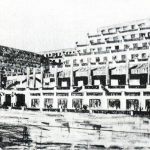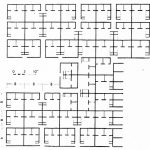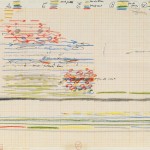Cornelis Meijer (Cornelius Meyer) (1629-1701) was a Dutch hydraulics engineer that came to Rome in 1680 to assist in the design of the banks of the Tiber river, the diverting of the water and the draining of the Pontine marshes. His two-volumes book Nuovi ritrovamenti (1689), (available in pdf online from the ETH Rara page) is a collection of engineering proposals related to his activity in Rome as well as to other heterogeneous designs for eyeglasses, bridges, carts, even automobiles and observations on the movement of the comets.
The book also includes a design for a one-room apartment (Del Fabricar Comodo). No complimentary text is provided, apart from a note on how fully satisfied the Vitruvian criteria of stabilità, fermezza and commoda may be within a restricted space. Four etchings and relative annotations about the project are present in the book.
As observed by Robin Middleton in his article “The one-room apartment” on AA Files, No. 4 (July 1983), pp. 60-64 (available online at JSTOR):
Meyer clearly liked ingenious and devious devices – listening tubes, spying glasses, secret connections and passageways, etc. Some of his obsessions, as one might expect, are close to Heath Robinson’s: fold-away furniture, for instance, or the reliance on the chicken and the egg for an instant food supply. Both men shared attitudes of mind. Both men were imagining frameworks of confinement, ultimately, no doubt, for the containment of their own cranky selves.
A less dismissive account on Meyer’s one-room apartment in the context of his Roman production may be found in Joseph Connors’s “The one-room apartment of Cornelis Meijer“, in: Nebahat Avcioğlu, Allison Sherman (ed.), Artistic Practices and Cultural Transfer in Early Modern Italy Essays in Honour of Deborah Howard, Ashgate / Routledge, 2015.
Meijer published this amusing jeu d’esprit in four etchings with long numbered captions in his Nuovi ritrovamenti of 1689. They show the four walls of what we could call a studio apartment inhabited by a virtuoso with an unusually compact lifestyle. Meijer begins by criticising the multiplication of specialised spaces in contemporary palaces, which have as a consequence the scattering of a gentleman’s possessions over a great number of rooms. He complains that one can never have all the accoutrements of a civilised life to hand when one wants them. In his model room, however, everything that a bachelor virtuoso could desire, lay within arm’s reach.
And after a thorough analysis of each wall’s drawing, Connors adds:
Meijer’s one-room apartment for the virtuoso gentleman is a deliberate provocation that flies in the face of fashions in Baroque domestic architecture. As Patricia Waddy has eloquently demonstrated, palaces in Baroque Rome were designed around a standardised apartment with an extendable enfilade of rooms. Visitors might congregate amidst footmen and guards in the main salone, but then they were received into the owner’s chambers, which consisted of a series of semi-private antecamere followed by a bedchamber, study and back stairs. Michel de Montaigne, who visited Rome in 1581, was so impressed by the difficulty of penetrating deep into the magnificent palaces of Rome, with their ‘divers porticoes and passages, long and pleasant galleries, and many windings’, that he used them as a metaphor for the usefulness of distance and degree in the most intimate of human relationships. The French author of a guidebook to Rome of 1677, after wandering through so many deserted rooms and antechambers in Roman palaces, imagines himself on an enchanted stage, where the master of the house awaits at the end of the enfilade, sullen and solitary, like the vanishing point of a perspective.
 First Wall 1. Ingenious door contrivance permitting the leaf to open on the left or the right. 2. A similar door, with self-closing device. 3. Cabinet with various drawers. 4. Desk with a bench to write and read. 5. Drawer for clothes for daily wear. 6. Cupboards for books. 7. Cupboard for ledgers and diaries. 8. Cupboard for letters and private papers. 9. Cupboard for curios. 10. String for curios. 11. Listening tube to find out what is happening in other rooms. 12. Speaking tube to make contact with other rooms and even afar. 13. Barber’s tray. 14. A chicken which can come in and lay eggs. 15. Ladder to reach upper levels. 16. Master key for all the locks. 17. Service bell. 18. Entrance bell. 19. Chairs that slide away within the walls. 20. Kennel for the dog.
First Wall 1. Ingenious door contrivance permitting the leaf to open on the left or the right. 2. A similar door, with self-closing device. 3. Cabinet with various drawers. 4. Desk with a bench to write and read. 5. Drawer for clothes for daily wear. 6. Cupboards for books. 7. Cupboard for ledgers and diaries. 8. Cupboard for letters and private papers. 9. Cupboard for curios. 10. String for curios. 11. Listening tube to find out what is happening in other rooms. 12. Speaking tube to make contact with other rooms and even afar. 13. Barber’s tray. 14. A chicken which can come in and lay eggs. 15. Ladder to reach upper levels. 16. Master key for all the locks. 17. Service bell. 18. Entrance bell. 19. Chairs that slide away within the walls. 20. Kennel for the dog.
 Second Wall 21. Alcove with doors behind with which the bed can be made. 22. Bed in alcove. 23. Door to alcove. 24. Urinal. 25. Brush and comb rack. 26. A longwinding clock (one year) with a lantern for night viewing. 27. Tool cupboard. 28. Cupboard for storing clothes. 29. Glass and beaker cupboard. 30. Linen cupboard. 31. Camera oscura to watch the activity in the street while yet in bed. 32. Gun cupboard. 33. Temperature gauge. 34. Dirty linen cupboard. 35. Cupboard for daily linen. 36. Secret stair connecting to other rooms. 37. Cupboard for silver bowls and beakers. 38. Cupboard for silver candlesticks. 39. Closet behind the bed which is permanently ventilated. 40. Handkerchief cupboard.
Second Wall 21. Alcove with doors behind with which the bed can be made. 22. Bed in alcove. 23. Door to alcove. 24. Urinal. 25. Brush and comb rack. 26. A longwinding clock (one year) with a lantern for night viewing. 27. Tool cupboard. 28. Cupboard for storing clothes. 29. Glass and beaker cupboard. 30. Linen cupboard. 31. Camera oscura to watch the activity in the street while yet in bed. 32. Gun cupboard. 33. Temperature gauge. 34. Dirty linen cupboard. 35. Cupboard for daily linen. 36. Secret stair connecting to other rooms. 37. Cupboard for silver bowls and beakers. 38. Cupboard for silver candlesticks. 39. Closet behind the bed which is permanently ventilated. 40. Handkerchief cupboard.
 Third Wall 41. Mirror. 42. Terrestrial globe. 43. Telescope. 44. Celestial sphere. 45. Microscope. 46. Gold scales. 47. Geometrical instruments. 48. Opening for fresh air. 49. Concave mirror to watch street activity. 50. Hand towel. 51. Calendar. 52. Memo pad. 53. Bird cage. 54. Wine cellar. 55. Seats let into the wall. 56. Sun clock. 57. Strongbox for gold. 58. Silver safe. 59. Jewel safe. 60. Lock.
Third Wall 41. Mirror. 42. Terrestrial globe. 43. Telescope. 44. Celestial sphere. 45. Microscope. 46. Gold scales. 47. Geometrical instruments. 48. Opening for fresh air. 49. Concave mirror to watch street activity. 50. Hand towel. 51. Calendar. 52. Memo pad. 53. Bird cage. 54. Wine cellar. 55. Seats let into the wall. 56. Sun clock. 57. Strongbox for gold. 58. Silver safe. 59. Jewel safe. 60. Lock.
 Fourth Wall 61. Fireplace for smoking meat. 62. Hot water cylinder. 63. Iron plate to retain heat and to prevent fire. 64. Fire dogs. 65. Grille to cover fire at night. 66. Spade. 67. Tongs. 68. Bellows. 69. Spice and medicine drawers. 70. Tapestry covered reclining chair. 71. Mortar. 72. Press. 73. Fold away table. 74. Food storage jars. 75. Stove and urn for distilling. 76. Board for cleaning and sharpening knives. 77. Hot and cold water taps. 78. Wood and charcoal store. 79. Oven for some things. 80. Oven for other things. 81. Crockery store. 82. Waste pipe with trap.
Fourth Wall 61. Fireplace for smoking meat. 62. Hot water cylinder. 63. Iron plate to retain heat and to prevent fire. 64. Fire dogs. 65. Grille to cover fire at night. 66. Spade. 67. Tongs. 68. Bellows. 69. Spice and medicine drawers. 70. Tapestry covered reclining chair. 71. Mortar. 72. Press. 73. Fold away table. 74. Food storage jars. 75. Stove and urn for distilling. 76. Board for cleaning and sharpening knives. 77. Hot and cold water taps. 78. Wood and charcoal store. 79. Oven for some things. 80. Oven for other things. 81. Crockery store. 82. Waste pipe with trap.




How about the fake dragon skull that he made out of dog bones Beaver fish & Bear?